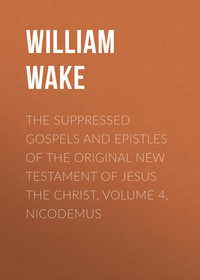Kitabı oku: «The suppressed Gospels and Epistles of the original New Testament of Jesus the Christ, Volume 4, Nicodemus», sayfa 8
REFERENCES TO THE GOSPEL OF NICODEMUS, FORMERLY CALLED THE ACTS OF PONTIUS PILATE
[Although this Gospel is, by some among the learned, supposed to have been really written by Nicodemus, who became a disciple of Jesus Christ, and conversed with him; others conjecture that it was a forgery towards the close of the third century by some zealous believer, who, observing that there had been appeals made by the Christians of the former age, to the acts of Pilate, but that such acts could not be produced, imagined it would be of service to Christianity to fabricate and publish this Gospel; as it would both confirm the Christians under persecution, and convince the Heathens of the truth of the Christian religion. The Rev. Jeremiah Jones says, that such pious frauds were very common among Christians even in the first three centuries; and that a forgery of this nature, with the view above-mentioned, seems natural and probable. The same author, in noticing that Eusebius in his Ecclesiastical History, charges the Pagans with having forged and published a book, called "The Acts of Pilate," takes occasion to observe that the internal evidence of this Gospel shows it was not the work of any Heathen, but that if in the latter end of the third century we find it in use among Christians (as it was then certainly in some churches), and about the same time find a forgery of the Heathens under the same title, it seems exceedingly probable that some Christians, at that time, should publish such a piece as this, in order partly to confront the spurious one of the Pagans, and partly to support those appeals which had been made by former Christians to the Acts of Pilate; and Mr. Jones says, he thinks so more particularly as we have innumerable instances of forgeries by the faithful in the primitive ages, grounded on less plausible reasons. Whether it be canonical or not, it is of very great antiquity, and is appealed to by several of the ancient Christians. The present translation is made from the Gospel, published by Grynaeus in the Orthodoxographa, vol, i, tom, ii, p. 613.]
Notwithstanding the diversity of opinions here alluded to, the majority of the learned believe that the internal evidence of the authenticity of this Gospel is manifested in the correct details of that period of Christ's life on which it treats, while it far excels the canonical Evangelists narrative of the trial of our Saviour before Pilate, with more minute particulars of persons, evidence, circumstance, &c.
